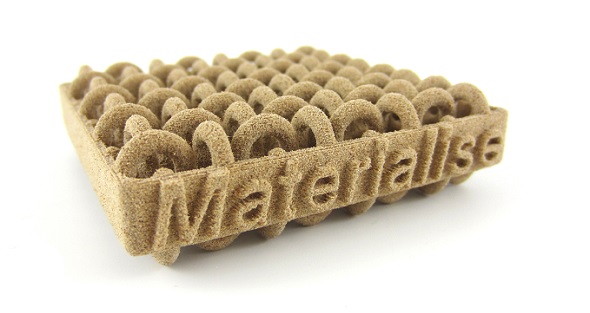Most of us have come to know – and in most cases appreciate – wood as a 3D printing material using it with PLA based filament for FFF desktop 3D printers. Starting with colorFabb’s woodFill and Formfutura’s LayWood, most manufacturers now offer it in one form or another and the only alternative was Emerging Object’s use of powdered wood through 3D Systems binder jetting technology. Until now, that is, because Materialise, through its i.materialise consumer 3D printing service division, just announced wood as a new material for its laser sintering 3D printing service capabilities.
Before officially launching a new material, Materialise has taken some time to fine-tune the production processes, get customer feedback and make sure that expectations are met. This is why the Belgian company is running a wood-challenge as part of a beta testing phase, asking every designer to participate in the trial period by submitting their creations by next June 14th. Five of them will be selected and printed free of charge.
The wood models will be constructed from a brown, very fine, granular powder made from wood chips. As my friend Guido Palazzo, a materials expert from the Centro de Investigación y Desarrollo para la Industria Plástic at the Instituto Nacional de Tecnologia Industrial in Argentina, pointed out, these will very likely be mixed with some kind of (yet undisclosed) polymer based material in order to make the wood effectively laser sinterable. In fact laser sintering pure wood powder would probably give only ashes as a final product. As the first photos show, the surface has a sandy, granular look, and is slightly porous.
Materialise’s laser sintetered wood resulted perfect for complex models, as it allows for interlocking and moving parts. The use of SLS, a process which has virtually no geometric limitations and requires no supports during printing, means that designers will enjoy a lot more freedom to create objects that cannot be realized with traditional woodworking methods or by extrusion based processes.
The machines used for the printing process enable a maximum size of 250 mm x 250 mm x 200 mm (which sounds compatible with the EOS Formiga’s working volume). Interlocking and moving parts are possible although enough space – at least 0.5 mm – should be left between the components in the 3D model. Designers should also keep in mind that the strength of wood is lower compared to other typically used SLS materials such as nylon, thus walls with a minimum thickness 3 mm are recommended. Also, hollowing out a model, by including a 15 mm diameter hole (or more holes) anywhere in the object, avoids deformation during the printing process.
Many times in the past I have had the opportunity to see that wood, more than a material from the past, is an ideal material for the future. Using it through advanced manufacturing process such as SLS will open up amazing possibilities, especially considering it can be produced from recycled woodchips. We’re not out of the woods, yet, as prices need to come down, but, knocking on wood, they will soon enough.




